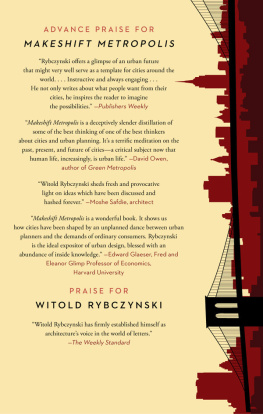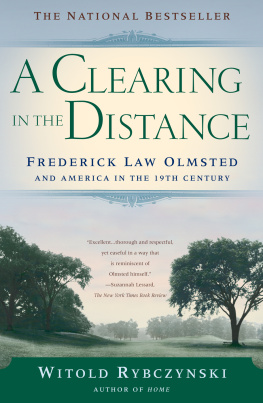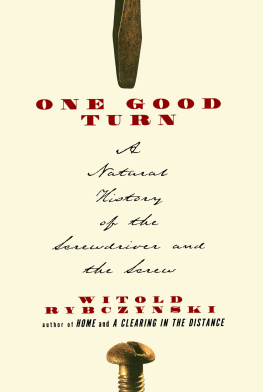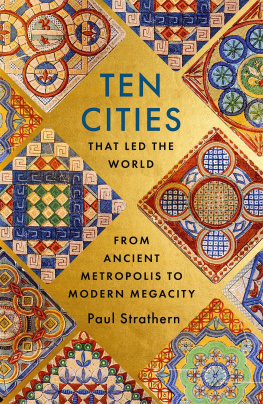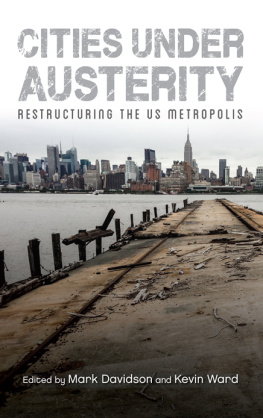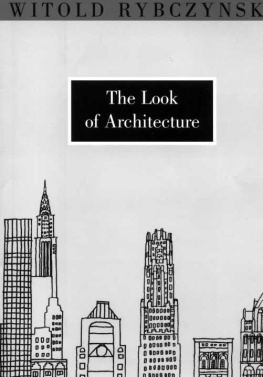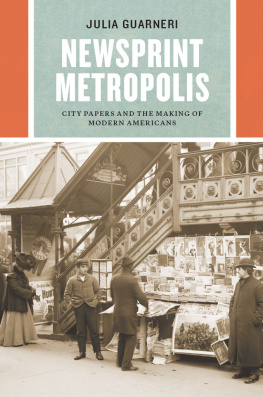
Other books by Witold Rybczynski
Paper Heroes
Taming the Tiger
Home
The Most Beautiful House in the World
Waiting for the Weekend
Looking Around
A Place for Art
City Life
The Perfect House
A Clearing in the Distance
One Good Turn
Last Harvest
My Two Polish Grandfathers

SCRIBNER
A Division of Simon & Schuster, Inc.
1230 Avenue of the Americas
New York, NY 10020
www.SimonandSchuster.com
Copyright 2010 by Witold Rybczynski
All rights reserved, including the right to reproduce this book or portions thereof
in any form whatsoever. For information address Scribner Subsidiary Rights
Department, 1230 Avenue of the Americas, New York, NY 10020.
First Scribner hardcover edition November 2010
SCRIBNER and design are registered trademarks of The Gale Group, Inc.
used under license by Simon & Schuster, Inc., the publisher of this work.
For information about special discounts for bulk purchases,
please contact Simon & Schuster Special Sales at 1-866-506-1949
or business@simonandschuster.com.
The Simon & Schuster Speakers Bureau can bring authors to your live event.
For more information or to book an event contact the Simon & Schuster Speakers
Bureau at 1-866-248-3049 or visit our website at www.simonspeakers.com .
DESIGNED BY ERICH HOBBING
Manufactured in the United States of America
1 3 5 7 9 10 8 6 4 2
Library of Congress Control Number: 2010030285
ISBN 978-1-4165-6125-5
ISBN 978-1-4165-6129-3 (ebook)
To
Martin Meyerson (19222007),
city planner, teacher, valued colleague,
and
Martin Pawley (19382008),
fellow garbage architect, writer, friend.
The city is a fact in nature, like a cave, a run of mackerel, or an ant heap. But it is also a conscious work of art, and it holds within its communal framework many simpler and more personal forms of art.
Lewis Mumford
But what we have to express in expressing our cities is not to be scorned. Their intricate ordera manifestation of the freedom of countless numbers of people to make and carry out countless plansis in many ways a great wonder.
Jane Jacobs
Contents
Preface
Like those of many architecture students of my generation, my ideas about cities were formed by reading Lewis Mumford and Jane Jacobs. While I pored over their books, in class and out, I was too green to see that in many important ways they were intellectual adversaries. Mumford, wistfully looking back at the preindustrial city, actively promoted a small-scale urban future planned according to the teachings of his mentor, Patrick Geddes. Jacobs, suspicious of planning in general and contemporary planning in particular, saw the city as having its own rules, rules that planners had largely ignored or, in the case of modern visionariesincluding Geddeswillfully usurped. I met Mumford once briefly, at a group lunch when he visited McGill University. He had witnessed the creation of modern architecture and planning, which gave him an almost mythic aura. A courtly gentleman, he was formal and somewhat distant, a figure from another age. Jacobs, iconoclastic, feisty, and outspoken, was much more appealing to an impressionable tyro.
A half century has passed since Jacobs wrote The Death and Life of Great American Cities, and the years have tempered my unseasoned judgments. Her offhanded dismissal of the City Beautiful and the Garden City, for example, now seems a little too easy; both movements left an indelible and positiveimprint on American cities. Her perceptive analysis of street life is circumscribed by what we have since learned about defensible space and community policing. And the urban world has changed in the last fifty years: the gradual disappearance of manufacturing has altered the face of many great American cities; poverty and racial division in inner-city neighborhoods persist; and suburban and exurban sprawl have become important engines of metropolitan growth. At the same time, a growing awareness of environmental issues has revived interest in Mumfords call for regional planning.
The debate between Jacobs and Mumford needs to be understood in a historical context, and weaves these strands together and demonstrates how the three ideasand Jacobss critiquehave played out in the evolving American city, reemerging as waterfront parks and new varieties of garden city suburbs. As for Wrights expansive vision of an ever-spreading urban frontier, reality has long since surpassed his expectation.
The American city as an unplanned, almost anarchic arena for individual enterprisea makeshift metropolishas, in many ways, fulfilled Jacobss vision. Yet, it has done so in unexpected ways. The most successful urban neighborhoods have attracted not the blue-collar families that she celebrated, but the rich and the young. The urban vitality that she espousedand correctly saw as a barometer of healthy city lifehas found new expressions, in planned commercial and residential developments, whose scale rivals that of the urban renewal of which she was so critical. These developments are the work of real estate entrepreneurs, who were absent from the Jacobite city described in Death and Life, but loom large today, having long ago replaced planners as our chief urban strategists.
This book summarizes what I have learned about city planning and urban development. Sixteen years ago I started teaching an introductory class in design and development to MBAs and real estate majors. I got to know my colleaguespredominantly economistsin the real estate department of the Wharton School. Without exception, I found them committed to urban research, studying housing, public finance, immigration, and urban poverty. Their overarching interest in the city is not so different from that of the architects and city planners in the School of Design, where I also teach; all share a common concern for improving cities and the lives of the people who live and work in them. But economists assume that to propose changes, you must first understand how things work. Consequently, their research is concerned less with what the city should be than with what it actually ishow it functions. This means gathering and analyzing vast amounts of data, trying to understand why people behave the way they do, live where they live, choose what they choose.
Although planning projects typically start with a functional analysis and an investigation of site conditions, traffic patterns, and so on, the main goal of the urban designer is to discover a novel physical solution to the problem at hand. Architects and planners are concerned with what they believe cities should be: safer, denser, greener, more diverse, more lively. The working assumption is that the designerwho is, after all, the experthas the interests of the users in mind and knows best how to achieve these worthy goals. In contrast, my economist colleagues are working on the problem from the other end, trying to discover what people themselves actually want.
Is a city the result of design intentions, or of market forces, or a bit of both? These are the questions I explore in this book. is an account of what we have learned about building and rebuilding cities, and how the lessons of the past fifty years appear to be coalescing into strategies that combine pragmatism and piecemeal development with public and private actions. The final two chapters contrast the kind of cities that Americans want, and the kind of cities that the present environmental crisis suggests that we need, which turn out to be not at all the same. Resolving this contradiction is the prime challenge for the next generation of city builders.
Next page
